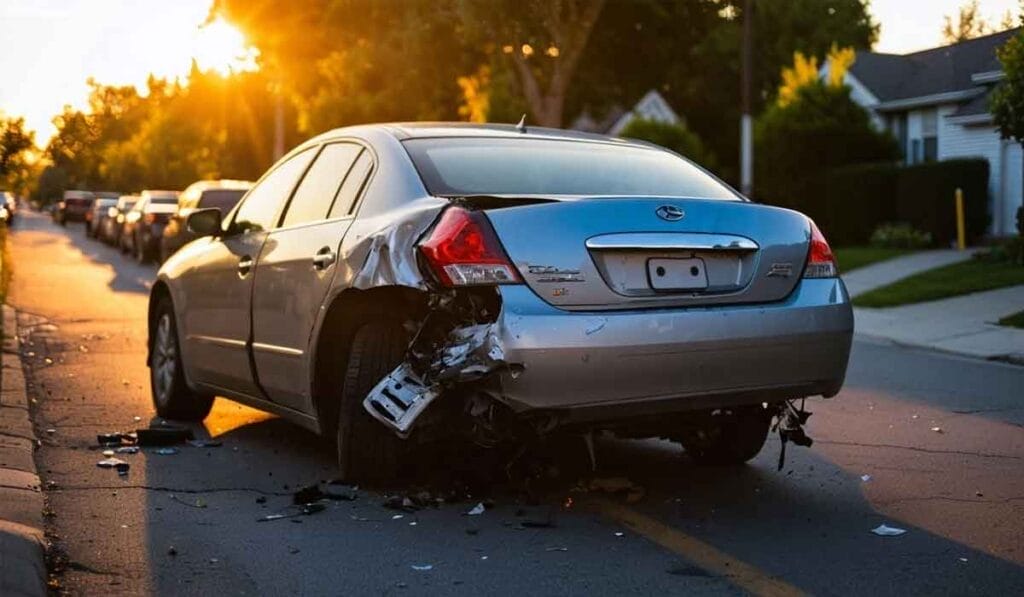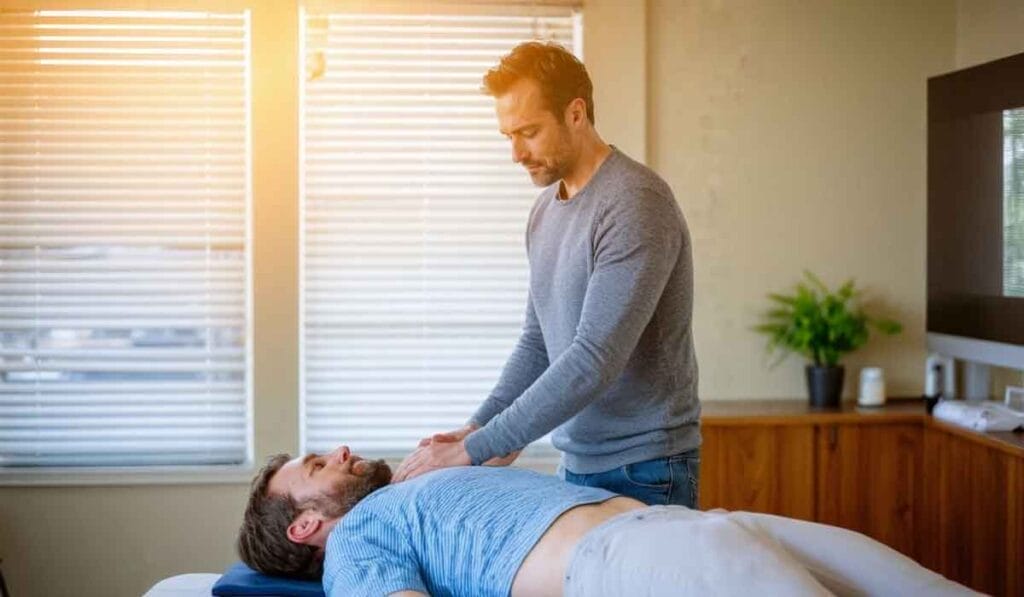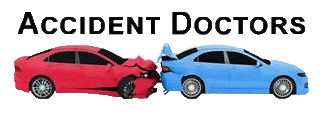The Ultimate Guide to Delayed Onset Muscle Soreness From A Car Accident
You’re feeling sore after a car crash, and you’re not alone.
Many people experience delayed pain following an automobile accident.
This article will guide you through understanding why this happens and how to manage it effectively.
Key Takeaways
- Your body might not feel pain right after a car accident because chemicals like adrenaline and endorphins hide it. Pain, especially from muscle injuries, often shows up days later.
- Injuries with delayed symptoms can include whiplash, concussions, spinal cord damage, and psychological trauma such as PTSD. These need prompt attention even if you feel fine right after the crash.
- Early treatment is key to recovery from car accident injuries. Chiropractic care, physical therapy, and massage therapy are effective treatments that target different aspects of injury and help speed up healing.
- After a car accident, taking immediate steps like checking for injuries and seeking medical attention can prevent worsening of conditions that have delayed onset symptoms.
- Keep an eye out for signs of serious problems after an accident like trouble moving or breathing normally; these could indicate hidden injuries needing quick treatment.
Please note: We are accident doctors who charge you $0 out of pocket for the best after car accident medical care.
We can help you overcome muscle pain from an accident too.
TIP: You should come in and get treated by us first, before you try and find an auto accident attorney in Phoenix or Mesa.
Why is Pain Often Delayed After Car Accidents?

Right after a car collision, your body pumps out chemicals like adrenaline. These make you feel alert and can hide pain.
Later, as these levels drop, the hurt from injuries like muscle strains may start to show up.
This is why you might not feel pain until days after the accident.
Adrenaline and endorphins

This reaction helps you cope with stress and shock, allowing you to act in the moment despite any trauma.
Your brain releases these chemicals as a response to stress or fear.
Adrenaline pumps up your heart rate, sending extra blood to muscles.
Endorphins work by blocking pain signals before they reach the brain.
Together, they prepare you to face immediate dangers but might hide serious injuries like spinal cord damage or soft tissue injuries.
In times of stress, adrenaline and endorphins act as the body’s built-in defense system.
After the danger passes, levels of adrenaline and endorphins drop. That’s when muscle soreness or other pain from hidden injuries can surface. Pain that seemed minor—or wasn’t felt at all—can become more noticeable.
This delayed onset muscle soreness is why it’s crucial not to ignore any discomfort following a car accident, even if it seems insignificant at first.
Musculoskeletal injury

Musculoskeletal injury from a car accident involves damage to your body’s structures, including bones, muscles, and joints.
These injuries can result in back pain, neck pain, or lower back problems.
They often come from blunt trauma during the crash. Your bones might not break, but your soft tissues—muscles and tendons—can get stretched or torn.
Car accidents also lead to specific injuries like herniated discs and whiplash.
A herniated disc happens when the cushion between your spinal bones pops out of place, pressing on nerves.
This can cause severe pain down your back or legs.
Whiplash is another common result where rapid forward and backward motion injures the neck’s soft tissues. Both conditions may lead to chronic pain if not treated properly.
Treatment options are essential for recovery from these musculoskeletal injuries. Chiropractic care helps realign your spine without surgery while physical therapy strengthens weak areas and improves flexibility.
Massage therapy soothes sore muscles, reducing inflammation and promoting healing throughout affected regions of your body.
Together with proper medical treatment by a healthcare professional; chiropractors, physical therapists, and massage therapists play crucial roles in helping you regain strength and mobility after an accident.
Common Car Accident Injuries with Delayed Symptoms
Right after a car crash, you might feel fine. But later, injuries like brain injuries or neck damage can show up without warning.
Whiplash

Whiplash happens when your head suddenly moves backward and then forward.
This quick motion can injure your neck’s bones, discs between the bones, ligaments, muscles, nerves, and other tissues of the neck.
Often, it occurs during car accidents but can also result from sports injuries or other types of trauma.
You might feel fine right after the accident but start to notice symptoms like neck pain, stiffness or headaches later on.
These whiplash symptoms can show up within days after the accident and might get worse before they get better.
Managing them early is key to recovery.
Taking care of whiplash early can prevent chronic pain.
Doctors use various methods to diagnose whiplash including physical exams and sometimes imaging tests like X-rays or CT scans if they suspect more serious injury such as a herniated disk or bone fractures.
Treatment often involves pain management techniques, exercises to strengthen neck muscles, and sometimes chiropractic adjustments or massage therapy for relief.
Concussions

Concussions are a type of traumatic brain injury that happen after a car accident.
They result when your head hits something hard or if the crash causes your brain to move quickly back and forth inside your skull.
This can damage brain cells and cause changes in how your brain works. Signs of a concussion might not show up right away, making it tricky to know you have one.
You could feel dizzy, have headaches, struggle with memory, experience mood swings, or find it hard to concentrate.
After an accident, even if you think you’re fine, keep an eye out for these symptoms.
A concussion needs medical attention to prevent serious problems like permanent brain damage or other neurological symptoms down the line.
Doctors may use computed tomography (CT) scans or magnetic resonance imaging (MRI) to check on your brain’s condition.
Early treatment often involves rest and slowly returning to daily activities under professional guidance.
If you face any signs of a concussion—like confusion, nausea, sensitivity to light, or sleep issues—seek help immediately.
These injuries are manageable when caught early but can lead to long-term health issues without proper care.
Taking steps toward recovery keeps you safe and ensures that short-term discomfort doesn’t turn into lasting damage.
Spinal cord injuries
Spinal cord injuries after a car accident can be serious and sometimes lead to long-term effects.
These injuries happen when there’s damage to the spinal cord itself or to the bones, disks, and ligaments that support it.
This type of trauma can result in paralysis, weakness in the legs or arms, and loss of sensation below the site of injury.
Your body might not respond right away; symptoms can develop hours or even days later.
Immediate medical attention is crucial if you suspect a spinal injury. Doctors use medical imaging tools like MRIs or CT scans to look at your spine closely.
Treatments vary from surgical interventions for severe cases, such as herniated disks or fractures, to less invasive methods like physical therapy and chiropractic treatments for milder issues.
Keeping an eye on any changes in feeling, movement, or strength is important – they might signal something needs attention.
Remembering these steps will guide you through recovery: stay calm, seek immediate help from healthcare professionals familiar with spinal traumas, and follow their advice closely.
Getting back on track requires patience and determination but focusing on your rehabilitation goals will make progress more tangible day by day.
Psychological trauma
Car accidents can leave scars not just on the body but also on the mind. Psychological trauma, such as post-traumatic stress disorder (PTSD), is a common aftermath of these terrifying events.
You might find yourself reliving the accident over and over or feeling anxious at the mere thought of driving again. These emotional wounds are real and can impact your daily life.
Taking steps to heal from psychological trauma is crucial for your overall well-being.
Simple activities like talking with a professional therapist or practicing guided imagery can make a big difference in coping with PTSD.
Remember, acknowledging emotional pain after a car accident is the first step toward recovery, allowing you to regain control of your mental and emotional health.
Managing Delayed Muscle Soreness

Taking quick action after a car accident can help manage delayed muscle soreness, encouraging you to get back on your feet.
Explore more tips and tricks to feel better soon.
Immediate steps to take post-accident
After a car accident, knowing what to do next is crucial for your health and legal standing.
You might not feel pain right away because of adrenaline, but taking these steps can help manage any delayed soreness or injuries.
- Check for injuries – Look over yourself and any passengers for obvious injuries. Even if you don’t see any, internal bleeding or a concussion might not be immediately apparent.
- Move to safety – If the accident is minor and your car is functional, move it to the side of the road to avoid further hazards.
- Call 911 – Reporting the accident is a legal requirement in many places. The police report will be valuable for insurance claims and legal action.
- Exchange information – Get names, addresses, phone numbers, insurance details, and license plate numbers from everyone involved.
- Take pictures – Use your phone to photograph the scene from several angles, including damage to all vehicles involved, road conditions, traffic signals, and any visible injuries you or passengers may have sustained.
- Seek medical attention – Visit a specialized accident doctor even if you feel fine right after the accident. Symptoms like lower back pain or abdominal pain can appear hours or days later.
- Report the accident to your insurance company – Informing them promptly helps with processing personal injury claims efficiently.
- Keep detailed records – Document everything related to the accident: medical visits (for TBIs or spinal injuries), missed workdays (lost wages), and conversations with your insurance company.
- Contact a car accident lawyer – They can guide you through filing a personal injury claim against an at-fault driver’s insurance company to cover medical expenses and other costs.
- Rest and follow up on treatment – Give your body time to recover while adhering closely to any treatment plans set by healthcare professionals for muscle soreness or other injuries sustained.
- Consider alternative therapies as recommended—physical therapy, chiropractic care (for spinal adjustments), massage therapy might offer relief for persistent pain areas like neck or facet joints.
- A new way of resolving pain without drugs is called Platelet Rich Fibrin. It is worth learning more about this revolutionary pain treatment system from Dr. Nguyen.
Following these steps ensures that you take care of both immediate concerns and longer-term health issues following an accident while also securing your rights for compensation regarding personal injuries sustained in the crash.
When to seek medical attention
Always seek medical help if you feel off after a car accident, even if symptoms seem minor.
Some injuries like internal bruising, pinched nerves in your back, or concussions might not show right away.
Pain can sneak up on you days later. Feeling dizzy, having trouble remembering things, or suffering from headaches means it’s time to see a doctor.
These could be signs of traumatic brain injuries (TBIs) or other serious conditions.
Notice changes in how you move and feel. Trouble breathing or sharp pains in your abdomen could mean something serious is wrong inside.
If walking feels different and knees seem weak, don’t wait to get checked out.
After trauma like a car crash, small symptoms can point to bigger health issues like deep vein thrombosis or facet joint injury.
Listen to your body closely after an accident; it often tells you when something isn’t right.
Watch for symptoms like excessive fatigue that doesn’t improve with rest, cramping that persists or worsens over time, and any new numbness…
these are red flags not to ignore. Early care can make a big difference in recovery times for injuries affecting muscles and bones or causing neurological damage.
Treatment Options for Post-Accident Soreness

Discovering the right treatment for post-accident soreness could be your key to faster recovery.
From gentle spinal adjustments to easing muscle pain with hands-on therapy, and enhancing tissue repair through innovative sound wave treatments, there’s a range of options tailored just for you.
Dive deeper into each method to find out how they can help you get back on your feet.
Chiropractic care
Chiropractic care focuses on your spine and musculoskeletal system to help you heal after a car accident.
This treatment can provide relief from back injuries, neck pain, and that frustrating feeling of pins and needles.
Chiropractors use their hands for spinal manipulations to bring everything back in order. These adjustments improve blood flow and nerve function, helping your body to recover naturally.
A healthy spine is the backbone of well being after an accident.
Imagine getting soft tissue therapy along with these adjustments.
It works wonders for relieving soreness and improving range of motion.
Techniques like ultrasound therapy might also be used, sending sound waves deep into your muscles to promote healing without surgery or drugs.
Whether it’s a lack of sleep due to pain or difficulty breathing properly, chiropractic care offers a non-invasive solution that addresses more than just the symptoms—it targets the root cause of discomfort following traumatic events.
Physical therapy
Physical therapy helps your body heal after a car accident. It slowly restores strength and reduces pain in muscles that got hurt.
Imagine getting back to picking up your kids or playing sports without wincing in pain—that’s what good therapy can do.
Therapists use exercises, hot packs, and sometimes machines to help you move better.
If you broke a bone or strained your back, physical therapy is crucial.
Starting might be tough, but each session builds on the last, helping you get stronger. You’ll learn special exercises tailored just for your injuries.
These aren’t one-size-fits-all; they’re designed to target exactly what needs healing in your body.
Your therapist will also teach you how to avoid future injuries.
They show you better ways to move and lift things safely—so important for keeping you out of harm’s way down the road!
Plus, seeing progress from one appointment to the next can really boost your spirits—it feels great knowing you’re on the mend.
Massage therapy
Massage therapy can offer significant relief if you’re dealing with muscle soreness after a car accident.
Through skilled hand movements, massage therapists work on your muscles and soft tissues to help reduce pain.
This treatment improves blood flow and reduces stiffness, making it easier for you to move around.
Not just for immediate discomfort, massage therapy also plays a crucial role in long-term recovery by preventing the buildup of scar tissue.
Engaging in regular massage sessions after an accident can speed up your healing process.
These sessions not only address the visible signs of distress but also target deeper layers of muscle that might have been impacted during the collision.
Think about how relieving it would feel to have those knots untangled and the tension eased out of your body.
Plus, there’s an added benefit – while focusing on your physical well-being, massage therapy also aids in reducing stress and anxiety that often accompany traumatic experiences like car accidents.
Remembering to include this therapy as part of your broader treatment strategy could make all the difference in how quickly and fully you recover.
Just imagine getting back to your daily activities without being held back by pain or stiffness from old injuries.
Conclusion

Understanding your body’s response to a car accident can help you heal faster. Remember, pain might not show up right away because of adrenaline and endorphins.
Common injuries like whiplash or concussions sometimes hide their symptoms for days.
Knowing what steps to take immediately after an accident is crucial—like when to see a doctor or start physical therapy.
Treatments such as chiropractic adjustments, rehabilitation exercises, or therapeutic massages play a big part in recovery.
Your journey to feeling better starts with recognizing these signs and taking action early.
FAQs
1. What is delayed onset muscle soreness after a car accident?
Delayed onset muscle soreness, or DOMS, refers to the pain and discomfort that develops hours or even days after a strenuous activity like surviving a car accident. It’s not as immediate as a broken bone but can be just as debilitating.
2. How does one recognize delayed onset muscle soreness from other pains?
DOMS usually starts within 12-24 hours after the traumatic event, peaks around 24-72 hours, and typically subsides within five to seven days. The symptoms are different from those of acute injuries such as fractures; they include stiffness, swelling, tenderness in muscles rather than sharp pain.
3. Can I prevent delayed onset muscle soreness after an accident?
Prevention might not always be possible especially when it comes to accidents… However, understanding its occurrence aids in managing expectations and seeking timely medical help—promoting faster recovery.
4. What should I do if I suspect I have DOMS from a car accident?
If you suspect you’re experiencing DOMS following an accident—you should seek medical attention right away! Early diagnosis can lead to effective treatment strategies easing your journey towards healing… Remember your health goals matter!

